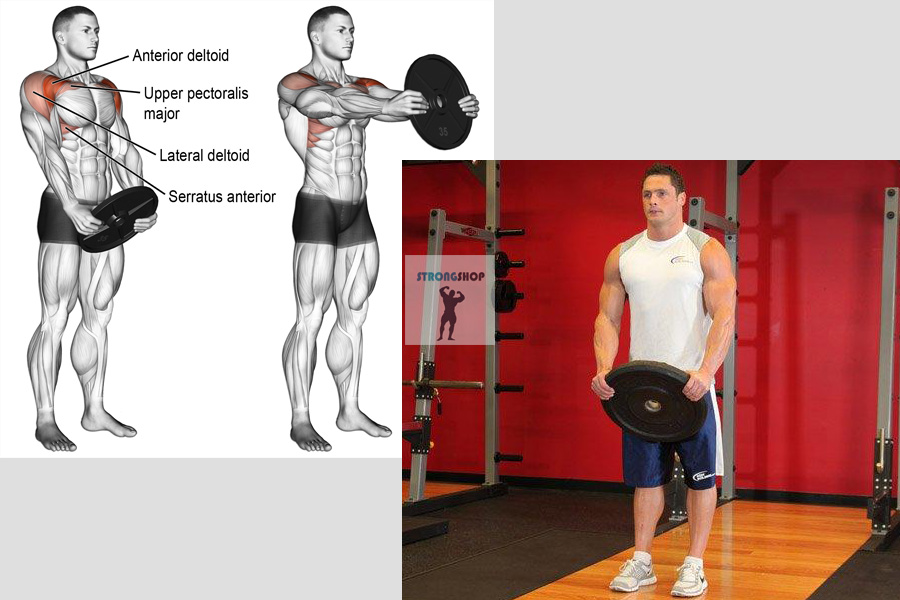The Plate Front Raises exercise is a simple exercise for working the shoulder muscles.
General Characteristics
- Exercise type: Isolation
- Equipment: Barbell plate
- Difficulty level: Easy, intermediate
- Main muscle groups: Anterior deltoid
In the English-speaking fitness community, it is known as "Plate Front Raises"
Application and Benefits
Plate Front Raises are used in training programs for:
Isolated development of the anterior deltoids — especially useful in cases of imbalanced shoulder muscle development;
Improving muscle definition and separation;
Increasing muscle mass in bodybuilding;
Serving as an auxiliary exercise in powerlifting to enhance pressing movements, such as the bench press.
Advantages
Minimal joint strain — thanks to the ergonomic shape of the plate;
Versatility — suitable for both beginners and experienced athletes;
Accessibility of equipment — barbell plates can be found in any gym. They are also usually available in home gyms.
Muscles Worked
The primary load during Plate Front Raises falls on the anterior deltoid muscles, which shape the shoulder definition. However, the exercise also engages:
- Lateral deltoids — stabilize the shoulder joint;
- Trapezius muscles — participate in controlling the movement;
- Core stabilizer muscles — engage to maintain balance.
Technique for Performing Plate Front Raises
- Stand straight, with your feet shoulder-width apart or slightly wider for stability.
- Hold the plate with both hands by the edges. It is most convenient to choose the one that has designated finger grip spots. Hold the weight in front of you at hip level, with your arms slightly bent at the elbows.
- Plate Raise: On the exhale, smoothly lift the plate in front of you to shoulder level or slightly higher.
- The movement should occur solely at the shoulder joint, with the arms remaining slightly bent at the elbows throughout the entire motion. The range of the Plate Front Raises should be controlled.
- Top Position: At the top, pause briefly and feel the tension in your anterior deltoids. Do not lift the plate too high to avoid engaging the trapezius muscles.
Lowering the Plate: On the inhale, slowly and in a controlled manner, lower the plate back to the starting position. Do not drop the plate; lower it smoothly while maintaining tension in the muscles. - Repetitions: Perform the required number of repetitions, for example, 10-12 repetitions for 3-4 sets.
Mistakes
Common mistakes that reduce the effectiveness of the exercise and increase the risk of injury:
Using too heavy a weight — leads to momentum and engagement of the back muscles instead of the deltoids. The working weight should be moderate, especially at the initial stage.
Full extension of the arms — creates excessive strain on the elbow joints. Even if the weights are not heavy, it is unnecessary.
Rounding of the back — disrupts core stability.
Sudden movements — increase the risk of ligament strains.
How to Avoid:
Start with a light weight, focusing on technique.
Control each phase of the movement.
Perform a light warm-up.
Conclusions
Plate Front Raises are a valuable exercise for targeted development of the anterior deltoid muscle, and can become an important part of your shoulder training program.
This exercise is suitable for both developing the shoulder girdle and enhancing strength performance in pressing movements.
By adhering to proper technique, avoiding mistakes, and progressively increasing the load, you can achieve significant results in developing shoulder strength and mass.
References to authoritative sources
https://www.youtube.com/watch?v=i9Ay9nNvfcI



